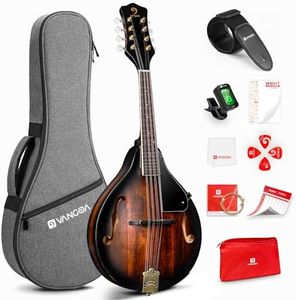10 Best Mandolins 2025 in the United States
Recommended lists
Our technology thoroughly searches through the online shopping world, reviewing hundreds of sites. We then process and analyze this information, updating in real-time to bring you the latest top-rated products. This way, you always get the best and most current options available.

Our Top Picks
Winner
Vangoa Mandolin Musical Instrument A Style Acoustic Electric, 8 Strings Mahogany for Beginner Adults Teens, Red Burst
Most important from
872 reviews
The Vangoa Mandolin A Style is a solid choice for beginner and advancing players looking for an acoustic-electric mandolin with good build quality. Its body is crafted entirely from AAA-grade mahogany, including the top, back, sides, and neck, which typically offers a warm, rich tone with good resonance — something often missing in cheaper models that use basswood. This wood choice enhances the instrument’s sound depth and durability. The neck is comfortable with rounded fret ends, and the scale length is standard for easy playability. The adjustable walnut bridge helps keep the string action low, making it easier to play, especially for newcomers. With 8 stainless steel strings and closed tuning pegs with an 18:1 gear ratio, tuning is stable and precise.
The built-in pickup adds versatility, allowing you to switch between acoustic practice and amplified performance without extra equipment. The mandolin also comes in a visually appealing red burst finish. While the mandolin is designed for beginners, the electric features provide additional options for those interested in amplified sound. The included bundle—picks, tuner, strap, chords, cable, extra strings, and a protective gig bag—offers great value, enabling players to start playing right away.
This Vangoa mandolin is well suited for those starting out or developing their skills, particularly if the option to plug in during performances is desired.
Most important from
872 reviews
Kentucky, 8-String Mandolin (KM-950)
Most important from
5 reviews
The Kentucky KM-950 8-String Mandolin is a well-crafted instrument that caters to both beginner and experienced players. Its solid carved Adirondack spruce top ensures superior note clarity and ample volume, making it suitable for various playing styles. The solid flamed Michigan maple back and sides add extra punch to its sound, enhancing its resonance and projection.
The slim maple neck offers comfortable and easy action, which is ideal for those who prioritize playability. The radiused premium ebony fingerboard not only provides durability but also adds to the aesthetic appeal of the mandolin. The high-gloss lacquer sunburst finish gives it a vintage look that many players will appreciate.
It is worth noting that the mandolin is made in China, which might be a consideration for those who prefer instruments manufactured in traditional mandolin-making regions. With a weight of just 1 pound and dimensions of 27 x 10 x 2.5 inches, it is lightweight and easy to handle. The phosphor bronze strings contribute to a warm and bright tone. This mandolin could be a great choice for those looking for a high-quality instrument with a classic look and robust sound, though it may not be the top choice for market-leading performance.
Most important from
5 reviews
The Loar LM-700-VS Supreme F-Style Mandolin
The Loar LM-700-VS Supreme F-Style Mandolin is a beautifully crafted instrument that appeals to both beginners and more experienced players. One of its standout features is the solid hand-carved AAA spruce top, which contributes to its exceptional sound quality, providing bright and resonant tones. The flamed maple back and sides add not only to its aesthetic appeal but also enhance its tonal richness. The one-piece maple neck with a rounded 'V' profile gives a comfortable grip, making it easier to play for longer periods.
The bound ebony fretboard is a nice touch, offering smooth playability and a luxurious feel under the fingers. The hand-buffed nitrocellulose lacquer finish in a vintage sunburst gives it a classic look that many musicians appreciate. With a scale length of about 14 inches, this mandolin strikes a good balance between playability and tone.
This mandolin might feel a bit heavy for some players, especially during extended playing sessions. Additionally, while its manual operation mode is perfect for those who enjoy traditional play, it might not suit players looking for more modern, electronic features. In terms of suitability, this mandolin is ideal for folk, bluegrass, and classical music enthusiasts, providing a rich sound and professional quality that can cater to various playing styles. If you're looking for an instrument that combines craftsmanship with outstanding acoustic performance, the Loar LM-700-VS could be a great choice for you.
Buying Guide for the Best Mandolins
Choosing the right mandolin can be a rewarding experience, whether you're a beginner or an experienced player. The key to finding the best mandolin for you is to understand the different specifications and how they affect the instrument's sound, playability, and overall quality. By considering your personal needs and preferences, you can make an informed decision and select a mandolin that will bring you joy for years to come.FAQ
Most Popular Categories Right Now



















